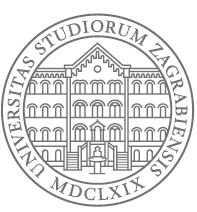Title Eksperimentalno i numeričko modeliranje zamornog ponašanja nodularnog lijeva Title (english) Experimental and numerical modelling of fatigue behaviour of nodular cast iron Author Predrag Čanžar Mentor Zdenko Tonković (mentor)Committee member Dorian Marjanović (predsjednik povjerenstva)Committee member Zdenko Tonković (član povjerenstva)Committee member Janoš Kodvanj (član povjerenstva)Committee member Franjo Cajner (član povjerenstva)Committee member Dražen Kozak (član povjerenstva)Granter University of Zagreb Defense date and country 2012-04-04, Croatia Scientific / art field, TECHNICAL SCIENCES Universal decimal classificationUDC ) 669 - Metallurgy 51 - Mathematics Abstract Većina komponenti modernih konstrukcija koje su izložene dinamičkom opterećenju i posljedično zamoru izrađene su od nodularnog lijeva normirane oznake EN-GJS-400-18-LT. Razlog tome je što se ovaj materijal odlikuje visokom istezljivošću i dinamičkom izdržljivošću čemu doprinose grafitne nodule u feritnoj mikrostrukturiranoj matrici. Navedeni materijal korišten je za izradu glavčine postojećeg KONČAR-vjetroagregata snage 1MW, ali i kod drugih proizvodnih komponenata tvrtke Končar, kao što su vlakovi, tramvaji, energetska oprema itd. Iz tog razloga istraživanje procesa deformiranja navedenog materijala predstavlja značajan interes od strane hrvatske industrije. Kako utjecaj mikrostrukture na mehaničko ponašanje nodularnog lijeva EN-GJS-400-18-LT nije dovoljno istražen, cilj rada bio je eksperimentalno istražiti utjecaj mikrostrukture na proces iniciranja i rasta oštećenja u materijalu te na temelju eksperimentalnih rezultata predložiti konstitutivni model s pripadnih numeričkim algoritmom za simuliranje procesa deformiranja materijala. Kako bi se mehaničko ponašanje materijala dovelo u vezu s mikrostrukturom materijala, u radu su analizirane četiri različite serije materijala dobivene različitim tehnologijama lijevanja. Karakterizacija grafitne morfologije kao i mikrostrukture matrice materijala obavljena je na pedesetak uzoraka za svaku seriju nodularnog lijeva. Provedeni eksperimenti obuhvaćali su statičko vlačno ispitivanje, simetrična i asimetrična ciklička ispitivanja s petljama histereze, ispitivanje lomne žilavosti, te ispitivanja u kojima se istražuje rast zamornih pukotina, za svaku od četiri serije nodularnog lijeva. Pritom je za detekciju nastanka i mjerenje rasta zamornih pukotina na površini epruvete razvijena nova optička metoda primjenom mjernog sustava Aramis. Eksperimentalni rezultati pokazuju da veličina, oblik i raspodjela grafitnih nodula nema značajan utjecaj na cikličko očvršćenje materijala, ali igra veliku ulogu u procesima nastanka i rasta pukotina. Zaključeno je da veće nodule nepravilnijeg oblika, nepovoljno utječu na zamorno ponašanje materijala u usporedbi s većim brojem manjih nodula pravilnog oblika. Nadalje, rezultati pokazuju da perlitna mikrostrukturna faza ne utječe značajno na zamorni životni vijek ukoliko njen udjel ne prelazi 10%. U okviru numeričkog modeliranja, postojeći algoritam za analizu problema cikličke plastičnosti ljuskastih konstrukcija, prilagođen je za trodimenijski konstitutivni model te je implementiran u programski paket ABAQUS. Točnost numeričkog algoritma provjeren je usporedbom s dobivenim eksperimentalnim rezultatima na epruvetama sa i bez zareza pomoću kojih je definiran kosntitutivni model. To je omogućilo točnije opisivanje stanja naprezanja i deformacija, kao i procesa nastanka i rasta pukotine u materijalu za slučaj cikličkih opterećenja.
Abstract (english) The vast majority of modern components and structures that are subjected to dynamic loads and consequently to the fatigue, are made of standard ductile cast iron EN-GJS-400-18-LT. Main reason for this is the fact that this material is characterized by high elasticity and dynamic endurance which is accomplished by ferritic microstructural matrix encompassing graphite nodules. This material was used for making the hub of KONČAR-1MW windmill, as well as in other Končar's product components, such as train, trams, power equipment, etc. For this reason the research of deformation processes of this material represents a significant interest from the Croatian industry. Since the influence of microstructure on the mechanical behaviour of ductile cast iron EN-GJS-400-18-LT is not sufficiently investigated, the aim of this study was to experimentally investigate the influence of microstructure on the process of damage initiation and growth as well as to develop a constitutive model with an appropriate numerical algorithm to simulate the deformation processes of materials based on the experimental data. Aiming to describe the influence of microstructure of the mechanical behaviour of materials, this paper analyses four different series of materials obtained by different casting technologies. Characterization of graphite morphology and material matrix microstructure was performed on fifty samples for each series of ductile cast iron. The conducted experiments included monotonic tensile tests, symmetric and asymmetric cyclic test with hysteresis loops, fracture toughness, and fatigue crack growth tests, for each of the four series of ductile cast iron. For the detection and measurement of fatigue crack growth a new method using an ARAMIS optical system has been developed. Experimental results show that the size, shape and distribution of graphite nodules have no significant effect on the cyclic hardening, but it plays a major role in the processes of crack initiation and propagation. It was concluded that the larger, irregular nodules, adversely affect the fatigue behaviour when compared with smaller, more regular nodules. Furthermore, the results show that the pearlite microstructure phase does not significantly affect the fatigue life if its share doesn't exceed 10%. In the frame of numerical modelling, the existing algorithm for analysing problems of cyclic plasticity of the shell structure, was adapted to the three-dimensional constitutive model and was implemented in the software package ABAQUS. The accuracy of the numerical algorithm was verified by comparison with the obtained experimental results on specimens with and without notch which were used to develop a constitutive model. For cyclic loading cases this allowed more accurate description of stress and strain fields, as well as processes of crack initiation and propagation in the material.
Keywords
nodularni lijev
mikrostruktura
eksperiment
zamor
numeričko modeliranje
ciklička pastičnost
rast pukotine
metoda konačnih elemenata
mehanika loma
koeficijent intenzivnosti naprezanja
J-integral
Keywords (english)
nodular cast iron
experiment
fatigue
crack
metallography
finite element method
damage
fracture mechanics
stress intensity factor
J-integral
Language croatian URN:NBN urn:nbn:hr:235:162189 Study programme Title: Mechanical Engineering and Naval Architecture Type of resource Text File origin Born digital Access conditions Open access Terms of use Repository Repository of Faculty of Mechanical Engineering and Naval Architecture University of Zagreb Created on 2020-05-08 07:49:29


